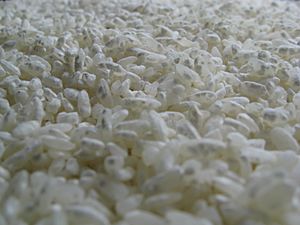Aspergillus oryzae facts for kids
Quick facts for kids Aspergillus oryzae |
|
|---|---|
 |
|
| A. oryzae growing on rice to make koji | |
| Scientific classification | |
| Genus: |
Aspergillus
|
| Species: |
oryzae
|
Aspergillus oryzae, also known as kōji mold (Japanese: ニホンコウジカビ (日本麹黴), Hepburn: nihon kōji kabi), is a type of fungus (a mold) that looks like tiny threads. It is very important in East Asia, especially in Japan. People use it to break down rice, sweet potato, and barley. This process helps make popular drinks like sake and shōchū.
A. oryzae also helps make soy sauce and miso by working with soybeans. However, for soy sauce and miso, another mold called Aspergillus sojae is often used more. This special mold is also used to make rice vinegar. When A. oryzae grows on grains like barley or rice, it creates something called kōji.
In 2006, a scientist named Eiji Ichishima from Tohoku University called kōji mold a "national fungus" of Japan. He did this because it is so important for many traditional Japanese foods. It helps make sake, miso, and soy sauce. His idea was approved by the Brewing Society of Japan.
The Japanese word kōji (麹) can mean different things. Sometimes it means A. oryzae specifically. Other times, it means any mold used in fermented foods, like Monascus purpureus. So, it is good to be careful not to get confused.
Contents
What Makes A. oryzae Good for Sake?
For making sake, certain features of A. oryzae are very helpful. These features make sure the rice breaks down well:
- Growing Fast: The mold needs to grow quickly on and inside the rice grains.
- Strong Enzymes: It must produce strong amylases. These are like tiny scissors that break down starches into sugars. It also needs some carboxypeptidase.
- Good Smell: The mold should create a nice smell and good flavors.
- Light Color: It should not make too many colored substances. This helps keep the sake clear and light.
Different Kōji Molds for Shōchū
There are three main types of kōji mold used to make shōchū, a Japanese alcoholic drink. Each type has its own special qualities.
Two important people, Genichirō Kawachi and Tamaki Inui, helped a lot with making shōchū. They were the first to find and grow different Aspergillus molds. This led to big improvements in how shōchū is made in Japan. Molds developed by Kawachi are also used in Korea for soju and makgeolli.
- Yellow Kōji (A. oryzae etc.)
This type is mainly used for sake. It used to be used for all honkaku shōchū too. But yellow kōji is very sensitive to heat. Its mixture, called moromi, can easily turn sour in warm places. This made it hard to use in warmer areas like Kyūshū. Because of this, black and white kōji became more common for shōchū. Yellow kōji gives a rich, fruity, and fresh taste. Even though it is hard to use, some makers still use it for its special flavor. Young people who did not like strong shōchū before now enjoy drinks made with yellow kōji.
- White Kōji (A. kawachii etc.)
Genichirō Kawachi found white kōji in 1923. It came from a change in black kōji. Scientists studied it and learned how to grow it on its own. White kōji is easy to grow. Its enzymes quickly turn starches into sugar. This is why most shōchū today is made with white kōji. It makes a refreshing, mild, and sweet drink.
- Black Kōji (A. awamori also known as A. luchuensis etc.)
Black kōji is mostly used for shōchū and awamori. Tamaki Inui first found and grew it in 1901. Later, in 1910, Genichirō Kawachi found a special type of A. awamori that made shōchū production even better. This mold makes a lot of citric acid. This acid helps stop the moromi from turning sour. Black kōji brings out the best flavors from the ingredients. It gives shōchū a rich smell and a slightly sweet, smooth taste.
One problem with black kōji is that its spores are black and spread easily. They can cover production areas and workers' clothes. This made it less popular for a while. But in the mid-1980s, new types of black kōji were developed. This made honkaku shōchū makers interested again because of the deep, good taste it creates. Now, many popular shōchū brands proudly say they use black kōji on their labels.
The A. oryzae Genome
The genome of A. oryzae was shared by Japanese biotechnology companies in 2005. A genome is like the complete instruction manual for an organism. A. oryzae has eight chromosomes. These chromosomes contain about 37 million base pairs and 12 thousand predicted genes. This means its genome is about one-third larger than some other related Aspergillus species. Many of the extra genes in A. oryzae are thought to be involved in making special chemicals. The specific strain of A. oryzae that was studied is called RIB40 or ATCC 42149. It was found in 1950 and is typical of the strains used for making sake.
History of Kōji
The word 麹 (which is qū in Chinese and kōji in Japanese) means mold used in fermented foods. It was first mentioned in a Chinese book called the Zhouli (Rites of the Zhou dynasty) around 300 BCE. The development of kōji was a huge step in Chinese food making. It provided the basic idea for three major fermented soy foods: soy sauce, jiang/miso, and douchi. It also helped create grain-based wines like Japanese sake and Chinese huangjiu, and li (which was like the Chinese version of Japanese amazake).
Images for kids
-
Conidiophores with conidia of the microscopic fungus A. oryzae under a light microscope
See also
 In Spanish: Aspergillus oryzae para niños
In Spanish: Aspergillus oryzae para niños



